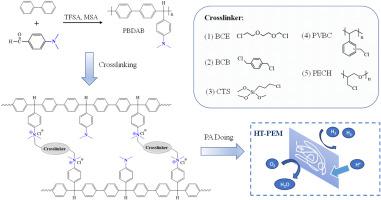Our official English website, www.x-mol.net, welcomes your feedback! (Note: you will need to create a separate account there.)
Covalently crosslinked poly(biphenyl dimethylamino benzene) membranes for high temperature proton exchange membrane fuel cells
Polymer ( IF 4.6 ) Pub Date : 2024-03-28 , DOI: 10.1016/j.polymer.2024.126992 Lei Li , Long Guo , Lele Wang , Qian Wang , Jingshuai Yang
Polymer ( IF 4.6 ) Pub Date : 2024-03-28 , DOI: 10.1016/j.polymer.2024.126992 Lei Li , Long Guo , Lele Wang , Qian Wang , Jingshuai Yang

|
The electrolyte membrane plays a pivotal role in high temperature proton exchange membrane fuel cells (HT-PEMFCs). Herein, we develops a new triarylmethane-backboned polymer, poly (biphenyl dimethylamino benzene) (PBDAB), synthesized through a facile one-step Friedel-Crafts reaction using biphenyl and 4-(dimethylamino) benzaldehyde as monomers. The presence of tertiary amine groups in PBDAB facilitates strong interactions with phosphoric acid (PA) molecules. To enhance the membrane's dimensional and mechanical stabilities, covalent crosslinking is performed via the Menshutkin reaction between the tertiary amine groups in PBDAB and chloromethyl groups in various crosslinkers. In order to study the influence of crosslinker chemical structure on the properties of PBDAB-based membranes, five different crosslinkers are employed, including small-molecule types such as 1,2-bis(2-chloroethoxy) ethane (BCE) and 1,4-bis(chloromethyl) benzene (BCB), siloxane type 3-chloropropyl (trimethoxy) silane (CTS), polymer types such as poly (vinylbenzyl chloride) (PVBC) and polyepichlorohydrin (PECH). Results reveal that the flexible and ether containing polymer crosslinker of PECH crosslinked membrane, denoted as CL-y%PECH, exhibits superior overall performance. When doped in an 85 wt% PA solution, the CL-5%PECH membrane achieves a PA uptake of 201%, resulting in an anhydrous proton conductivity of 0.064 S cm at 180 °C and a mechanical strength of 7.2 MPa at room temperature. Using H and O as fed gases without humidification and backpressure, a single cell with abovementioned membrane attains a peak power density of 302 mW cm at 160 °C. This work offers a kind of promising PBDAB based membranes for HT-PEMFC applications.
中文翻译:

用于高温质子交换膜燃料电池的共价交联聚(联苯二甲氨基苯)膜
电解质膜在高温质子交换膜燃料电池(HT-PEMFC)中起着关键作用。在此,我们开发了一种新的三芳基甲烷主链聚合物,聚(联苯二甲氨基苯)(PBDAB),该聚合物通过使用联苯和4-(二甲氨基)苯甲醛作为单体的简便的一步傅克反应合成。 PBDAB 中叔胺基团的存在促进了与磷酸 (PA) 分子的强烈相互作用。为了增强膜的尺寸和机械稳定性,通过PBDAB中的叔胺基团与各种交联剂中的氯甲基基团之间的Menshutkin反应进行共价交联。为了研究交联剂化学结构对PBDAB基膜性能的影响,使用了五种不同的交联剂,包括小分子类型,如1,2-双(2-氯乙氧基)乙烷(BCE)和1,4 -双(氯甲基)苯(BCB)、硅氧烷型3-氯丙基(三甲氧基)硅烷(CTS)、聚合物类型例如聚(乙烯基苄基氯)(PVBC)和聚环氧氯丙烷(PECH)。结果表明,PECH交联膜的柔性含醚聚合物交联剂CL-y%PECH表现出优异的综合性能。当掺杂在85 wt% PA溶液中时,CL-5%PECH膜的PA吸收率为201%,导致180℃下的无水质子电导率为0.064 S cm,室温下的机械强度为7.2 MPa。使用 H 和 O 作为通气,无需加湿和背压,具有上述膜的单电池在 160 °C 时达到 302 mW cm 的峰值功率密度。这项工作为 HT-PEMFC 应用提供了一种有前途的基于 PDBAB 的膜。
更新日期:2024-03-28
中文翻译:

用于高温质子交换膜燃料电池的共价交联聚(联苯二甲氨基苯)膜
电解质膜在高温质子交换膜燃料电池(HT-PEMFC)中起着关键作用。在此,我们开发了一种新的三芳基甲烷主链聚合物,聚(联苯二甲氨基苯)(PBDAB),该聚合物通过使用联苯和4-(二甲氨基)苯甲醛作为单体的简便的一步傅克反应合成。 PBDAB 中叔胺基团的存在促进了与磷酸 (PA) 分子的强烈相互作用。为了增强膜的尺寸和机械稳定性,通过PBDAB中的叔胺基团与各种交联剂中的氯甲基基团之间的Menshutkin反应进行共价交联。为了研究交联剂化学结构对PBDAB基膜性能的影响,使用了五种不同的交联剂,包括小分子类型,如1,2-双(2-氯乙氧基)乙烷(BCE)和1,4 -双(氯甲基)苯(BCB)、硅氧烷型3-氯丙基(三甲氧基)硅烷(CTS)、聚合物类型例如聚(乙烯基苄基氯)(PVBC)和聚环氧氯丙烷(PECH)。结果表明,PECH交联膜的柔性含醚聚合物交联剂CL-y%PECH表现出优异的综合性能。当掺杂在85 wt% PA溶液中时,CL-5%PECH膜的PA吸收率为201%,导致180℃下的无水质子电导率为0.064 S cm,室温下的机械强度为7.2 MPa。使用 H 和 O 作为通气,无需加湿和背压,具有上述膜的单电池在 160 °C 时达到 302 mW cm 的峰值功率密度。这项工作为 HT-PEMFC 应用提供了一种有前途的基于 PDBAB 的膜。



























 京公网安备 11010802027423号
京公网安备 11010802027423号